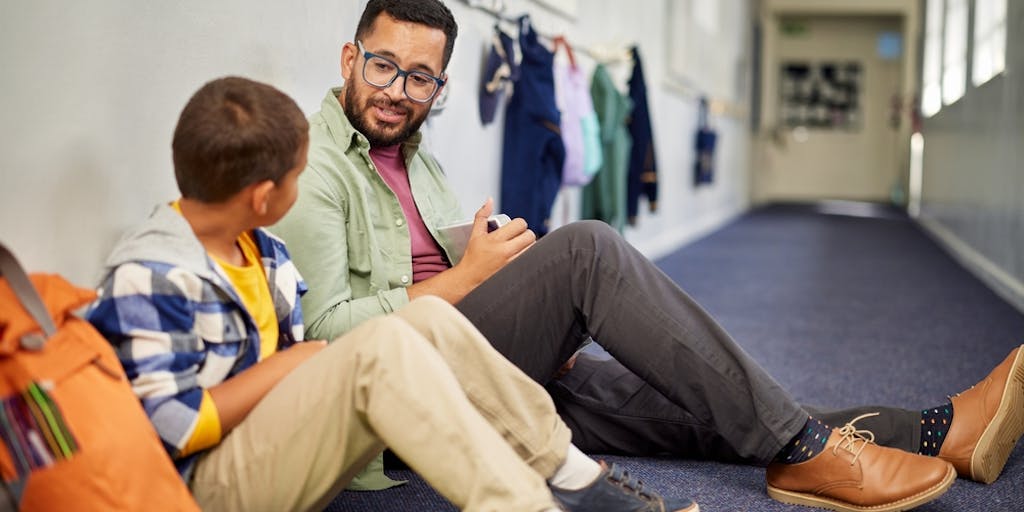Have you ever made a student cry? I have.
Earlier this year, one of my fourth year students continued to disrupt my instructions during lessons. This behavior was unusual for her. I had taught her last year and she had always been attentive and committed. I tried various class management strategies: positive narration, proximity and attention engineers from the whole class. Nothing worked. Finally, I issued a verbal warning. Cut by the consequence, she shouted through the room: “I was even doing nothing!”
Her answer amazed at me, not only because she had shouted, but because of whom she was – a student who had been a leader in my class, someone with whom I had built a strong relationship by teaching art the previous year.
I approached and asked him quietly to go out with me. She got up, slammed her chair against the office, rolled her eyes and let out a groan of embarrassment. Outside the classroom, I turned to her and asked: “What's wrong?”
“Nothing,” she mumbled, turning away.
I hesitated. “Is everything going well?” I asked again, perplexed by its change in behavior.
“Yeah,” she replied, but her tone, flat and unconvincing, suddenly contrasting with the calm and collected student that I thought I know.
I didn't know what to do. But before they could completely deal with the situation, the words left my mouth instinctively: “I'm sorry.”
I continued: “It seems that you had a bad day, and maybe I said something that upset you. I did it? If I did, is there something I can do differently next time?”
She froze. Then, suddenly, silent tears sank on his cheeks.
I felt horrible, worried that I made things get things worse. She stood there, unable to speak, tears flowing on her face. I didn't want to push it further. I stretched her the pass of the corridor and told her to walk, wash her face and drink water. I reassured her that she could return to the lesson every time she was ready, and if she needed more time, she could go to the calm corner. Then I returned inside and continued to teach.
For weeks, I couldn't stop thinking about his reaction. I did not expect my excuses to push her to tears. What had struck him so deep?
This moment forced me to face a difficult truth about teaching: we often talk about respect, kindness and emotional consciousness, but how often do we model them? How often do we demand that the students apologize after an argument with a classmate? And how often do we only receive a little reluctant marmonage “I'm sorry” in return? We expect the students to admit when they are wrong, but as a teacher, we rarely do the same.
Teaching is more than content delivery – it is a question of modeling humanity, and my apologies that day reshaped my understanding of the deeper goal of education.
Education as a humanizing practice
In “Pedagogy of oppressed“, Paulo Freire maintains that education should make students more human. This should nourish self -awareness, critical thinking and emotional intelligence, not just conformity. But too often, in particular in schools serving marginalized communities, we are experiencing obedience on connection. We emphasize control rather than empowerment, strengthening the rigid power structures which reflect the inequalities that students experience outside schooling.
This achievement made me rethink the dynamics of power in my class. By apologizing to my pupil, I did not concede authority, but rather, I moved it. I showed her that she deserved respect and that her emotions imported. I taught him, through action rather than by words, that errors, including mine, are not signs of weakness but possibilities of growth.
And I saw the impact.
Since that day, his behavior has improved considerably. Not because she fears the consequences but because she feels valued. She listens carefully, undertakes deeply and does her best, even when the work is difficult.
The power to apologize as a teacher
The apology did not weaken my authority – it strengthened it. This has shown my students that learning is a permanent process that includes humility and responsibility.
Too often, children and young people rarely hear apologies from adults, especially those in a position of power. But if we want to teach students to sail in the world with empathy and integrity, we must first model it ourselves. A real excuse is an act of courage. He recognizes the fault and shows a desire to do better. This also points out to students that they have the right to be heard and also respected.
I undertake to promote critical consciousness in my students, by giving them the tools to challenge the structures of power and help them to understand what the human being means. Changing the dynamics of power in a classroom does not mean losing control – this means transforming space into a space where students consider themselves active participants in their own education.
Apologizing was a small act, but he challenged traditional hierarchies, demonstrating that respect should flow in both directions. This helped to humanize my class, to strengthen the idea that errors – on both sides – can lead to deeper learning.
What it means to be educated
What I first saw as a moment of disruption in class has become a deep lesson in humility and connection. The tears of my student did not relate to the warning that I had given him. They were to feel seen, recognized and appreciated.
It's been almost six months since that day, and its transformation continues to remind me of an essential truth: education is not only to master the content. It is a question of preparing students to move around the world with empathy and self -awareness. If we want students to resist dehumanization, we must first model humanization.
And sometimes it starts with a simple “I'm sorry”.


